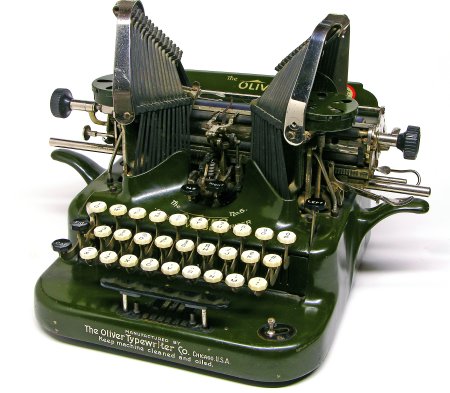Many people might consider three-bank typewriters to be oddities from a time when typewriters were still relatively new inventions and new, improved designs were continually being experimented with.The truth is, three-bank typewriters were very popular. Integrating the third row of numbers and symbols into the three letter rows not only economized on moving parts, but created a smaller typing space for the typist's fingers to have to traverse. A modern typist used to the ubiquitous four-bank typewriter or computer keyboard might find the three-bank configuration slow and awkward at first, but with practise a skilled typist can type just as quickly if not faster than on a standard keyboard. This gallery is a tribute to those machines which found a following in the early decades of the 20th Century, only to die out after World War II.
![]()
 Second possibly to only the Corona 3 (see below), the Oliver was one of the most successful three-bank typewriters ever made. Over a million of these tank-like beasts were sold between 1894 and 1928. After the Oliver Typewriter Company was sold to a British firm, the Oliver name was applied to rebranded Fortuna and Halda four-bank typewriters, though the familiar three-bank winged machine continued to be produced off and on through 1947. From the mid-1930s on, the Oliver name also appeared on rather standard four-bank portables which bore little relation to the original. Second possibly to only the Corona 3 (see below), the Oliver was one of the most successful three-bank typewriters ever made. Over a million of these tank-like beasts were sold between 1894 and 1928. After the Oliver Typewriter Company was sold to a British firm, the Oliver name was applied to rebranded Fortuna and Halda four-bank typewriters, though the familiar three-bank winged machine continued to be produced off and on through 1947. From the mid-1930s on, the Oliver name also appeared on rather standard four-bank portables which bore little relation to the original. |
The Harris (which also went by the names Rex and Demountable) found its way into many homes thanks to the original Home Shopping Network, the Sears catalog. Although not nearly as solid as the Oliver and having a rather harsh keyboard touch, the Harris is the only one of the group featured here to feature basket shift. All of the others move the carriage up and down, which can be quite tiring on the poor pinky finger that has to work the Fig key. Note, too, that this is the only machine of the group to offer a second, right-hand Fig key. After an in-depth study of serial number sequences by Will Davis, It's now thought that this machine may have been one of 800 purchased by Sears for internal office use, as opposed to sale though its catalog. |
Toward the end of its run, Corona 3s were offered in bright colors as Corona Specials. |
On a personal note, this particular three-bank machine is very pleasant to type on, despite a few language-barrier obstacles. (The Z and Y keys are interchanged, with lowercase Y being the Fig shift of ß.) |
|
|